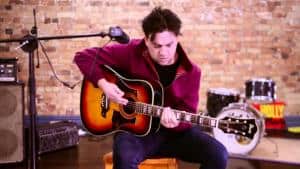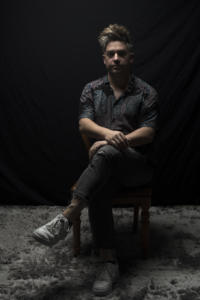Eden Mulholland talks Rushes, Rooms and Writing
Eden Mulholland released a string of sweet indie pop albums a few years backand then disappeared. Now he’s resurfaced with a newly composed soundtrack for the Opera Peer Gynt, written a score for a dance company and recorded a few songs, including his latest release Forwarding Backwarding. Tim Gruar had a chat to him on a balmy summer’s day in one of the Capital’s wonderful inner-city parks, talking about his new collaboration, the interactive dance production Rushes, for the upcoming New Zealand Festival.

Eden tells me he has been in Perth since the start of the year with his wife, Erin (formerly of Footnote Dance Company) who is working as Co3 dance company dance director. Eden also composes for Co3. They are a nomadic couple, working with various dance companies in Australia, occasionally teaming up with his brother Jol (Anika Moa, et al) who is working “as a producer at large.” (Spoiler alert: Jol will be releasing an album later this year, though Eden’s lips are sealed on what that might look like). Eden is also still making pop music – in between festival gigs – having just released a new single called Forwarding, Backwarding, which will be performed in this show as well. The long-term plan is to release an album soon. His dance card also features trips to China and Fiji for writing excursions.

Rushes, Eden’s latest project, and the reason we are chatting, first featured at the Auckland Fringe Festival last year to great critical acclaim. Presented by the dance company Movement of the Human, the show is currently moving in to city’s harbour front Circa Theatre, creating a veritable rabbit warren of unique performance spaces made of contemporary temporary materials. The show will blend together live music, audio/visual projections, dance and physical theatre. It’s the brain child of choreographer and director Malia Johnston (formerly Footnote Dance Company), exploring “how our relationship to physical space can influence the way in which we experience a performance, creating an immersive environment that gives audiences the freedom to explore.” That’s according to the press release. Creating the show was a collaboration between Eden and old friends Malia Johnston, Rowan Pierce (AV) and John Verryt (set design), who all know each other from their time working with Footnote Dance Company, Black Grace and other projects. Eden explains more:
Why is the show called Rushes?
EM: “We like the word: Short, snappy. In film terms ‘rushes’ are the daily shots taken that you look at and decide on what to edit. They are kind of sketches, unfinished, the raw deal. What we are after with this show is kind of like that. The idea is really playful. The concept that not everything you do has to always be completely polished. This is a combination of improvisation and script – with the added element of audience participation. All wrapped up in neat little packages.”
TG: I’m a punter. I want to come along to the show. What will I see? What should I expect?
EM: “It’s interactive in the sense that it’s like a gallery. So, you wander around the performances as they are happening. You (the audience) don’t actually touch but you do react, and the performers feed off that. Especially, as the audience stand so close. You can view for any angle. You can stay in a room as long as you like. You may just stay in one rom. It’s up to you.”
TG: How does he music work. With all these rooms, is the music different for each?
EM: “It’s a locked-in set (he means the music), playing the same in every room. We are at the Circa theatre. We’ve made rooms using paper and scenery in the hall, foyers, bar, offices, and the theatres and performance space. But the band is in one place playing across the whole building. But in each room the dancers are different. There are 14 tracks and in between each is a jam – a moment for the audience to move from room to room. Music is live. But there is a roadmap that the performers will follow, so it’s structured but there’s room to ‘move’ how they see fit with in that, too. So, the dancers know where they are in the work but there’s also a lot of scope with in those works, too.”
TG: So, how do the audience react? Do they press a button, or something else?
EM: “No. No. Not at all. It’s a gallery. There are 20+ rooms and in each is a different performance happening. The cast is about 40 strong. Some actors. Some dancers – all ages from 18 to 50+. You wander around and through these corridors with installations of light and visual projections. There may be a dancer in a corner or the centre or not even there.”
TG: Give me an example of one of these rooms.
EM: “There’s one room called the sustainment room. The dancers are constantly moving through the whole period of time. Like a moving statue. You can look at it like that. You can wander around, have a drink, talk to friends or other audience members – like you would in an art gallery.”
TG: Objectifying art and bodies? Like the red-light district, the windows in Amsterdam. The human selection and discrimination?
EM: “A different kind of dancing (he laughs). But in a way that’s one point of what we are saying. Dancing is a celebration of the body and we do look for the perfect. Or the perfect depiction of that. This might be an improvisation of that. A sort of choreography and improvisation experience. And it’s not the high art of the ballet. It’s more tactile. In some cases, the experience and the work allows you to put on your own interpretation.”
TG: Who comes to shows like this?
EM: “Everyone. Friends and family of the cast. Young and old. Last year, when we did the show in Auckland, the audience were encouraged to tear down the paper-thin walls we’d created. It was a cathartic explosion of music and light. The music builds up to the end.”
TG: Where did the work come from, the ideas and the themes?
EM: “I’ve known (choreographer) Malia Johnston for about 20 years. And I’ve also worked and written shows with Rowan (Pierce) – who does the audio-visual content for a long time, too. This project is a culmination of ideas we’ve done separately and together over that whole time. It’s just another way to explore a long-term theme of ours to have the audience more included. It’s like part of an experiment as opposed to the usual proscenium arch separating the audience and performers. We are trying out ideas in real time and you can take the experience away with you. No body but you can have that exact experience.”
TG: You have a pop background. You are used to audiences jumping up and down and being interactive?
EM: “Yeah. Everyone loves the ‘down on the floor’ vibe. Sitting all still and quiet in the auditorium is fine – this is not that. You can be who you are as an audience member. When we did the show in Auckland we noticed how positively people responded. Some even danced along or tapped their feet. Like at a concert. There’s no pressure to interact but somehow they feel part of it and the energy build and builds until everyone realises they are working to build something together which is really neat!”
TG: Your brother, Jol, is on board too?
EM: “Yes. He and I are playing synths, computers and digital ‘toys’. Jol has a stack of synths and he’s doing all this crazy shit. We have a band too. There’s even a fiddler, Annabel, who pops up at one point, and goes from room to room playing in time (with us). The music is a collection of existing works that Malia and I have made over the years. And I’ve chopped in some other things and all played live. Some dancers are also playing instruments. In a way, it’s all re-interpreting what we’ve done. Music is really upbeat, driving rhythms, almost like a club. Drums, sax, guitars. Layers, loops, indie songs with vocals, weird sounds. Melodic energy that builds and builds, looping and layers.”
TG: Tell me how the show flows.
EM: “You arrive and are welcomed with some music. Grab a drink from the bar then head down the corridors and you are set free to wander the rooms and explore, following a ‘path’ then eventually make your way to a final room which has a bit of a surprise! You’ll have to come along to see what that is.”
The New Zealand Festival 2018 season of Rushes is presented in collaboration with Te Papa and Circa Theatre and shows at Circa Theatre, 1 Taranaki Street, Wgtn from 23 Feb – 5 March. Performance times: Friday 23 Feb preview: 8pm, Saturday 24 Feb – Monday 5 March: 7.30pm, Sundays: 4pm, No show: Monday 26 Feb
http://edenmulholland.net/
https://edenmulholland.bandcamp.com/
A short sample of Forwading Backwarding is available here: http://hyperurl.co/edenmulholland
- Civil War – Dir: Alex Garland (Film Review) - April 9, 2024
- Pearl Jam – Dark Matter (Monkeywrench/Republic) Album Review - April 1, 2024
- Blonde Redhead – New Zealand Tour 2024 - March 14, 2024
